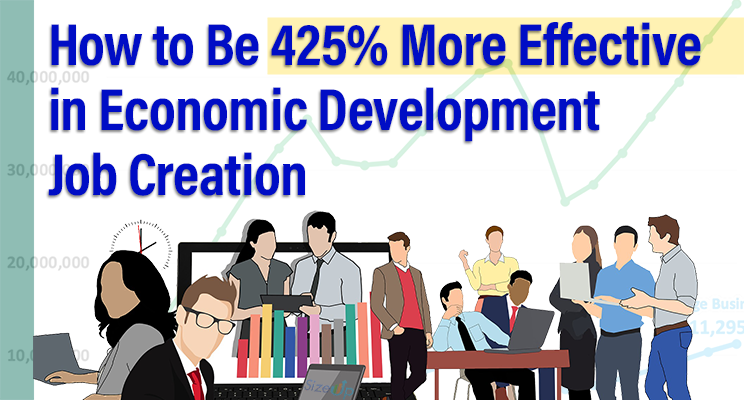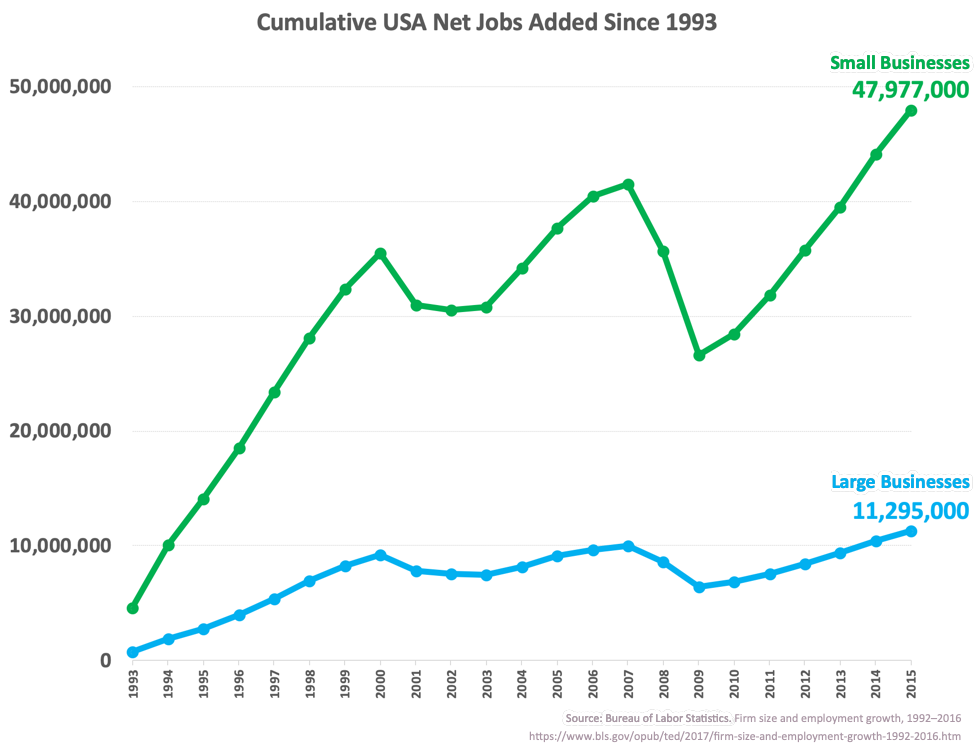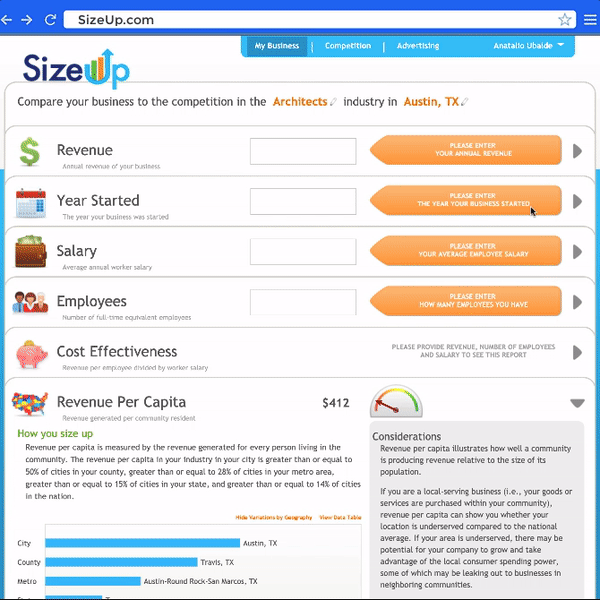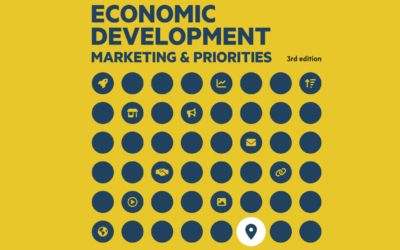
For nearly every state, region, and local economic development organization the number one priority and mission is the creation of new jobs. National surveys show this is the goal.[1] When it comes to evaluation of success and failure, job creation is how organizations are measured. Considering just how much job creation is a priority for economic developers, the obvious question to solve is: Where do new jobs come from so I can get those new jobs?
The answer to this question is actually incredibly simple. It’s so simple that if you do just one thing, you can typically out-perform the economic developers that are focused on attracting mega-projects by 425%.
First, it’s worth defining what mega projects are. They are the business attraction projects into your community from outside your area that get a lot of news, that corporate site selection consultants are talking about, and for which teams of economic developers scattered across the continent engage in a battle using all the professional weapons at their disposal so they have a chance at winning a company location project that delivers 500 or 10,000 or maybe even 100,000 new jobs. These have included the Foxconn plant, Boeing headquarters, McKesson headquarters, Tesla Gigafactory, and Amazon HQ2 (“Did we say 150,000 jobs? Just kidding, we’re cutting that in half!”). These are the projects that Governors are willing to change their names to win. Or that city councils are willing to change the name of their city to win, but then don’t win.

A mega project is sensational stuff that shows up in newspapers, television, blogs, and sometimes even Saturday Night Live. It involves lots of money and politicians. Because they want to win, governments are willing to cut lucrative incentive deals to give these big businesses advantages that the companies that have been in their community for years won’t get.
However, if you look beyond the bright lights and fame related to winning (but most will be very publicly losing) these deals, you will discover that a focus on big businesses is a long-term strategy that underperforms for job creation. Instead, the real winners in economic development do something very different and they out-perform their competitors who are chasing these epic-sized business attraction projects.
What is this simple strategy that delivers the most jobs and out-performs chasing big businesses by 425% over the long term? The answer is small business. That’s right; if you want the biggest job creation you need to think small. Because small business is big job creation.
Numerous surveys, research, and studies prove the outsized performance of small businesses is true. For example, compelling national data from the United States Bureau of Labor Statistics over the last 23 years for which data exists is definitive and convincing. Here it is:


Were the fireworks after showing this chart a little too exuberant for this insight? I don’t think so. Should I have used the “mic drop” meme? Maybe. But before showing the “mind blown” animated gif, it’s worth discussing exactly what this chart shows and how you can benefit from the competitive advantage of knowing this data insight.
- This chart shows the cumulative number of net new jobs created each year starting in 1993. If more jobs were added the line goes up and if jobs were lost it goes down.
- There were two recessions over this time period. The first was the dot-com bubble that started bursting in 2001. The second was the Great Recession which started in December of 2007. During these times you see that job growth declined as jobs were eliminated.
- From 1993 to 2015 small businesses created 425% more jobs than large businesses.
If a typical economic development organization made the decision in 1993 to focus exclusively on creating new jobs from large businesses they would have experienced relative failure, resulting in only 24% of net new jobs compared to if they decided to focus exclusively on job creation from small businesses. Or, an alternate way to measure this is that if you were an average economic development organization that made the decision in 1993 to focus exclusively on creating new jobs from small businesses you would have had the very real success of 425% more job creation than the economic development organizations that focused exclusively on big businesses.[2]

It’s clear where the creation of new jobs comes from and where economic developers can get them. It’s small businesses. However, to be an effective economic developer it’s also essential to understand what you can do to enable getting your fair share (or more) of net new jobs from small businesses by empowering your local entrepreneurs and small businesses to be successful.
There are a variety of effective small business assistance programs that economic development organizations can implement which reach different volumesof small businesses. There are programs that can serve many, some, or a few small businesses. These programs are further described here.
1. Serve MANY Small Businesses
Online services provide a convenient way for entrepreneurs and small business owners and employees to access services whenever they want, wherever they are, and with the increasingly popular method of do-it-yourself assistance. This is also one of the easiest ways for economic developers to implement small business assistance as it requires the least (or almost no) staff time and is the lowest cost.
Online Training
Business education and training from top university professors can now be accessed by entrepreneurs for free through the Massive Open Online Courses (MOOC) provided by edX. The global non-profit edX has four key university partners including MIT, Harvard, University of California at Berkeley, and The University of Texas system, along with over 120 other institutional partners. There are currently over 450 available courses for business and management with subject areas including digital strategy, economics, finance, product development, and operations. All courses can be audited for free or can be taken to receive a verified certificate for a fee. As an economic development organization, you can link to these services from your website and promote these professional development opportunities to small businesses and entrepreneurs in your community.
There are also for-profit online business training platforms such as Udemy that provide thousands of courses for small business owners, managers, and entrepreneurs. Udemy has promoted itself as helping “organizations of all kinds prepare for the ever-evolving future of work.” Udemy exists within the MOOC movement outside of traditional universities, it has positioned that “Udemy believes that the world’s best teachers aren’t always found in the classroom” and that their instructors are “experts who stay active in their fields in order to deliver the most up-to-date content”.[3] Because courses on Udemy must be purchased, EDOs could consider allocating small business training budgets to subsidize the costs for local companies wanting to access this customized job training education.[4]
Online educational training like edX and Udemy are scalable to as many small businesses that can watch the online courses and can be accessed anywhere with an Internet connection, which solves the two big barriers that exist in current small business assistance programs.
Online Research
In today’s information economy, businesses without access to information are at a higher risk for failure or stunted growth. Large corporations can afford to hire management consultants and research analysts to use data to gain insights and plan a path for their success. Small businesses are informationally disadvantaged in today’s society because they have not been able to access, afford, or understand business intelligence like large companies. Fortunately for small businesses, now there is a way for EDOs to help level the competitive business playing field by providing their local businesses with easily understandable market research based on big data, algorithm-based analysis, super-computing, and which is delivered through the Internet.

Economic development organizations place SizeUp LBI research services on their websites to provide their local companies with customized access to high-quality data and market research that is specific by detailed industries and hyper-local to be relevant. Now small companies can access similar business intelligence used by huge corporations so that they can benchmark and rank their performance against industry competitors; discover potential customers, suppliers, and better understand the competitive landscape; optimize advertising to target ideal customers; and granularly analyze local and regional demographics to uncover market opportunities. The service is free to local small businesses and affordable for EDOs.
Online business research using SizeUp LBI on economic development organizations’ websites is scalable to as many small businesses that want the custom data research and it can be accessed anywhere with an Internet connection, which solves the two big barriers that exist in current small business assistance programs.
2. Serve SOME Small Businesses
National business assistance organizations and shared office space for incubation provide opportunities to help some of the small businesses in your area. These types of programs can be more personally engaging through face-to-face interaction. Neither is as scalable as online services. However, both have more human interaction.
National Small Business Programs
The US Small Business Administration oversees the direct delivery of small business services through Women Business Centers (WBC), Veteran Business Outreach Centers (VBOCs), SCORE, and Small Business Development Centers (SBDC). WBCs and VBOCs provide services to targeted demographics of entrepreneurs and small businesses.[5] SBDCs and SCORE focus on the general population of small businesses wanting assistance.[6] Services primarily focus on “how to” classes, mentoring, workshops, and individualized advisory services, however the types of services vary by organization and location. Services include business planning, accessing capital, marketing, regulatory compliance, technology development, international trade and more.[7]
The reason that these national small business programs serve some small businesses but are not able to serve large numbers is because of the dependence on human and financial resources and also because geographic access to these centers is limited.[8] The Association of SBDCs provided data on the number of businesses they serve, which is approximately 3% of all US businesses.[9]
Incubators and Coworking
Although not present in all communities, business incubators have been around for many years to help early stage companies.[10] By 2010 there were 1,600 incubators across the USA.[11] Incubators provide a physical location with shared services to help the company get started and become stable enough to venture into an independent location. They often reduce costs by having shared office resources such as telephone, internet, meeting rooms, and reducing initial capital investments in items such as copiers and office equipment. In addition, they may provide small business training and education because all of the co-located tenants tend to be in similar situations in the stage of their business and need to learn the basics of operating a business.
More recently the private sector has entered the incubator market in the form of coworking spaces. These coworking buildings have appealed to new companies and the growing number of contract workers. WeWork is one of the most popular of the coworking real estate companies although there are many types of coworking spaces run by different non-profit, government, and for-profit organizations. These coworking office spaces often provide similar benefits found in traditional business incubators.

There is growing research which examines the potential ineffectiveness of incubators and whether they are simply self-serving. Research from the Kauffman Foundation show that most incubators typically only have 2 employees but serve 25 businesses on average. They question the plausibility that so few employees can impact so many companies. Kauffmann’s research also shows that there is not much study or evidence that incubated companies out-perform unincubated companies. A dissertation from Alejandro Amezcua shows that incubated businesses have higher job creation and sales growth but lower survival rates after graduating, however, these variations were marginal.
If your organization has an incubator/accelerator or is considering starting or attracting one, to be successful the incubator needs to have the correct resources, staffing, mentors, and evaluation to make sure your incubator is adding value.
3. Serve FEW Small Businesses
An alternative to serving many businesses is to help a diminutive group of companies that show indications of an ability to grow rapidly. This provides a select group of businesses with special attention. A risk to this approach is that the larger audience of local businesses may feel excluded from this assistance. Programs that exclude also risk falling into the narrative that economic developers engage in picking the winners and losers.
Economic Gardening
Economic Gardening is a business assistance program that accelerates the growth of local businesses which economic developers identify to be potential “gazelle” winners that can grow quickly. In Economic Gardening programs EDOs provide staff consulting to fast-growing companies through the use of databases, software-driven analysis, and making connections. This process focuses on delivering service to a few gazelle companies that show the greatest potential for growth and job-creation. It requires research staff expertise and subscriptions to software and databases.
Economic Gardening has defined itself as an alternative to traditional business attraction because it focuses exclusively on local businesses. A recognized limitation of Economic Gardening is that it only serves a small number of businesses which are already showing success and, if the services are provided to anything other than innovation companies, it has similar effects of business attraction by simply stealing market share from other geographic areas.
Accelerators
Another type of physical entrepreneurship space is the business accelerator. These are typically designed to help an early stage business with the potential to grow rapidly, to grow quickly through direct assistance. These accelerators tend to focus more on high technology startups. They are located at universities and are now also more commonly led by private sector ventures that bring in venture capital and make corporate introductions for the startups. Examples of these types of accelerators include Plug and Play, 500 Startups, and Y Combinator.
Accelerators tend to fall into three categories:[12]
- Growth-driven: programs are primarily dependent on growing the startup as it generates revenue from equity
- Fee-driven: programs charge clients member and service fees as well as rent
- Independent: programs are supported not by income from startups, but by sponsors, public funds, and events
The challenge for some EDOs is that most accelerators are in some of the largest metro areas and most dynamic economies of the country. As such, there is always the challenge that the participating businesses may remain in the metros in which they are accelerated, so sending your local businesses to these established accelerators is a risk. Another challenge is the questionable efficacy of accelerators and incubators, as was previously described.
What Will You Do With The Answer?
Now you have the answer to what to do to create the most jobs: it’s small business. And you also have the programs and strategies to implement for helping your small businesses.
Although no small business assistance program is perfect in every way, each provides unique benefits. If you want to help many of them, implement online small business assistance. If you want to help some of them, get them into national small business assistance programs like Small Business Development Centers, SCORE, Women Business Centers, Veteran Business Outreach Centers. If you want to help a very few, elite small businesses, you can implement your own economic gardening program by hiring new staff, retraining your existing staff, and subscribing to new software and databases. In addition, you can help direct your small businesses into existing business accelerators or create your own.
You have the answer and the path to the greatest success in creating new jobs. Now it’s up to you to deliver on the greatest opportunity available to you.

Footnotes:
[1] International Economic Development Council, “State of the Industry 2019”.
[2] I hope you are intellectually curious enough to ask the question “How is small business defined in this analysis?” Great question and thanks for asking. The US Small Business Administration defines small businesses in a variety of ways depending on the industry. It could be a business of 250 employees or 1,500 employees. It also classifies companies by different revenue ranges. For the chart in this analysis it uses a number on the lower end of this range at 499 or fewer employees. However, you may say “Hey, that’s still a lot of employees to be considered a small business.” And to that response I would say, “I’m not the SBA and I don’t make its rules, but you make a great point.” If you feel this way and you think that small businesses should be companies with 249 or fewer employees, then, over the 23 years of 1993 to 2015, small businesses generated a cumulative 329% more net new jobs than big businesses with 250 or more employees. However, maybe you would still say “Hey, that’s still a lot of employees to be considered a small business.” And to that response I would repeat, “I’m not the SBA and I don’t make its rules, but you make a great point.” If you feel this way and you think that small businesses should be companies with 99 or fewer employees, then, over the 23 years of 1993 to 2015, small businesses generated a cumulative 237% more net new jobs than big businesses with 100 or more employees. Even by this measure small businesses out-perform big businesses by 237% in net job creation, which is a massive difference in effectiveness. Of course, there are some people and organizations that define small business as anything under 1,000 employees. If you see things this way then small businesses generate a cumulative 545% more net new jobs than businesses with 1,000 or more employees.
[3] Udemy About Us webpage. May 2019.
[4] I hope you noticed what I did there. EDOs are already familiar with paying for and providing Customized Job Training programs. Online professional training in which the entrepreneur is choosing custom training courses is also getting Customized Job Training. Perhaps this will make it easier for you to access funding from existing economic development program budgets for online education.
[5] Women Business Centers help women succeed in business by providing training, mentoring, business development and financing opportunities to over 140,000 women entrepreneurs each year in every state in the union. Source: Association of Women Business Centers.
[6] SCORE provides business mentors and has helped more than 11 million entrepreneurs through mentoring, workshops and educational resources since its founding in 1964. In 2018, SCORE mentors helped start 32,387 businesses and create 135,687 jobs. Source: https://www.score.org
[7] America’s Small Business Development Centers. https://americassbdc.org
[8] Nationwide, there are only 128 Women Business Centers and only 22 Veteran Business Outreach Centers. In many cases only one or zero centers are in each state. The Association of SBDCs describes that it is “the most comprehensive small business assistance network in America” and that the nearly 1,000 SBDCs in the US and US territories serve over 1 million small business owners and aspiring entrepreneurs each year. As the leader in providing small business services it is laudable that, on average, 1,000 small businesses and entrepreneurs are served annually by each SBDC. However, to put this in perspective, there are 35,856 municipalities and townships in the USA and 30.2 million small businesses. This equates to less than one SBDC for every 35 counties and only 3% of all US businesses being served.
[9] The ASBDC states that they serve over 1 million small business owners and entrepreneurs each year. The US Small Business Administration Office of Advocacy 2018 Small Business Profile measures that there are 30.2 million small businesses. Even fewer small businesses than 3% are likely served because SBDC includes entrepreneurs in their service statistics and these people may not have yet opened businesses.
[10] In the book The Wizard of Menlo Park, Randall Stross argues that incubators and accelerators have existed (although not called by those names) since the late 19th Century.
[11] Amezcua, Alejandro S., “Boon or Boondoggle? Business Incubation as Entrepreneurship Policy” (2010). Public Administration – Dissertations. 80. Syracuse University.
[12] Houque, Faisal, “Do Accelerators And Incubators Serve Themselves Better Than Startups?” FastCompany. January 2016



